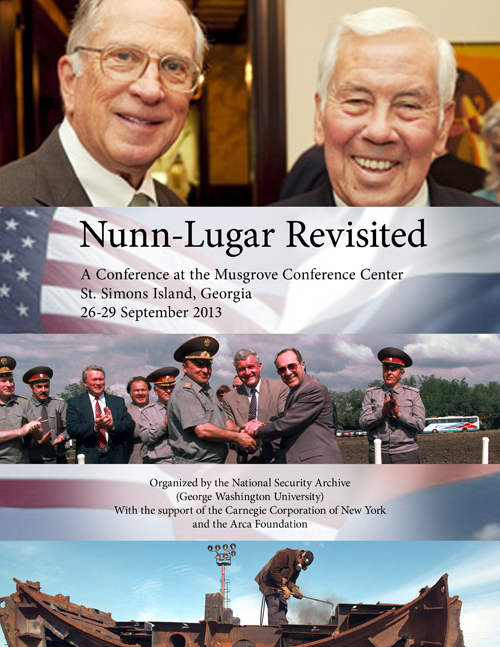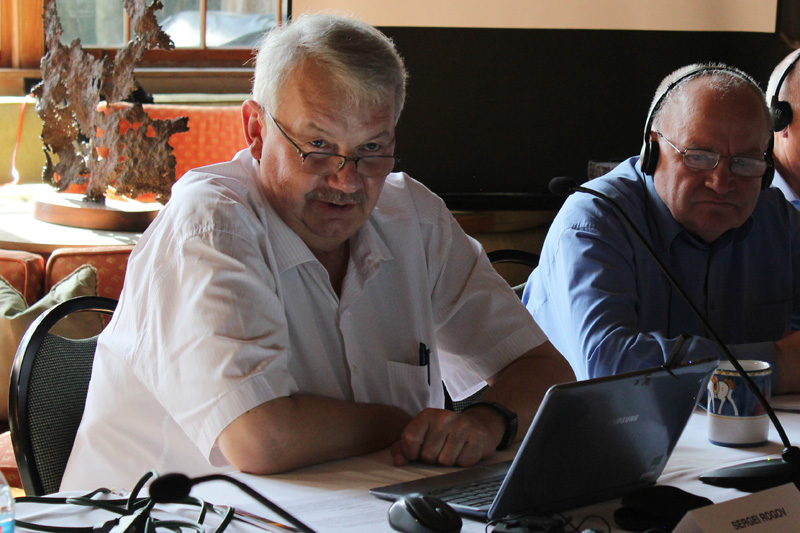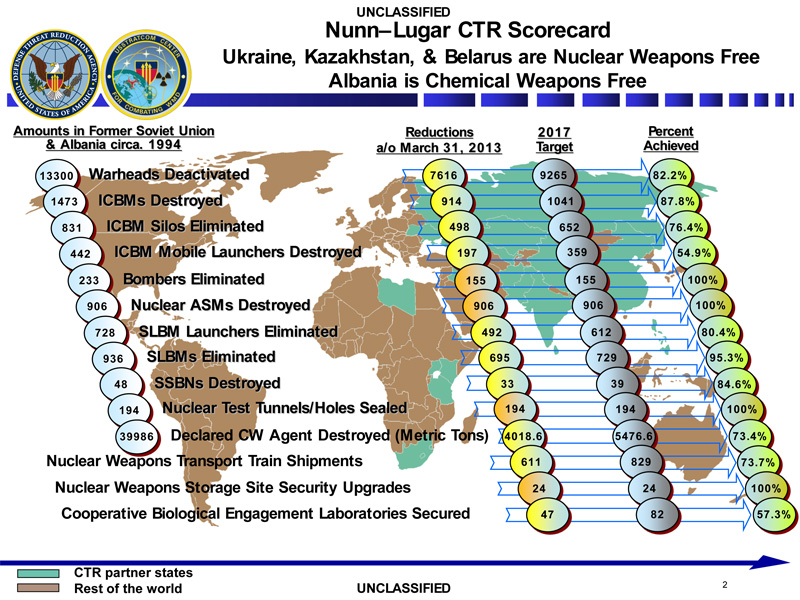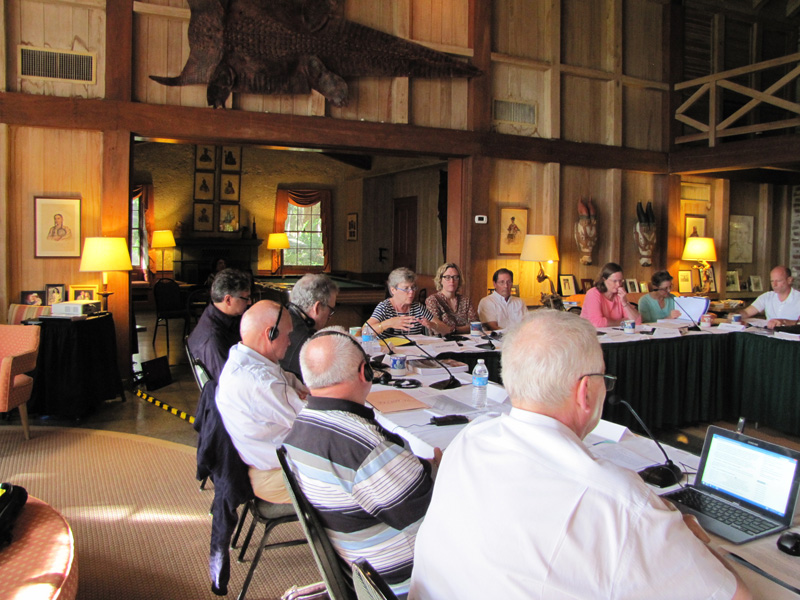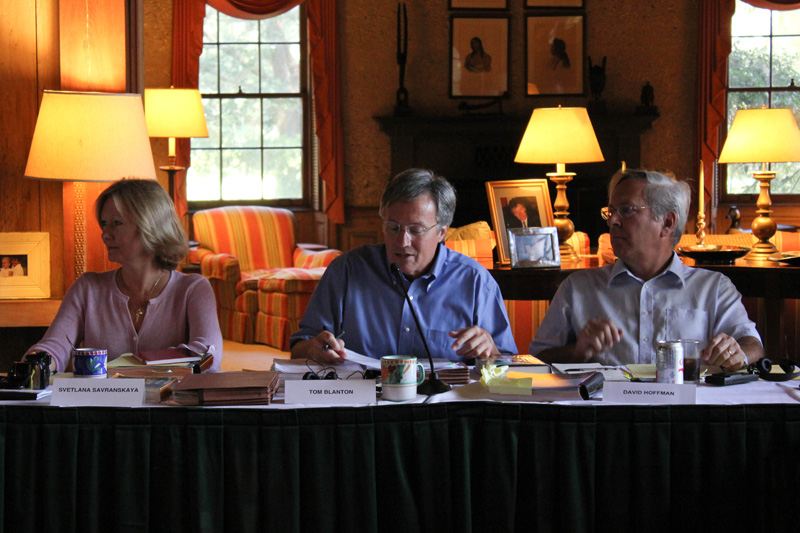IN THE NEWSRemarks by the President at Presidential Medal of Freedom Ceremony U.S.-Russia uranium deal sends its last shipment Saving the world at Plutonium Mountain
|
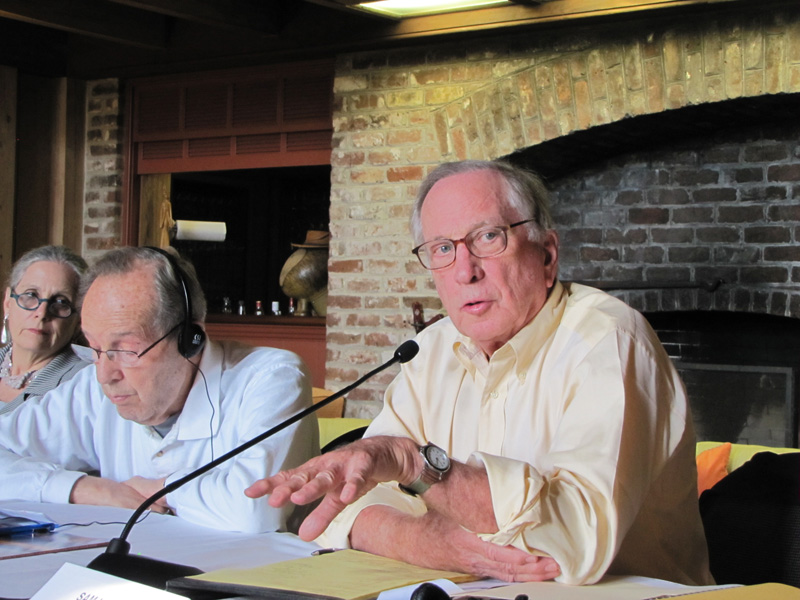 Senator Sam Nunn details the politics of denuclearization at the Musgrove conference; to his right, Bill Perry and Gloria Duffy, September 2013. Washington, DC, November 22, 2013 – The final shipment of highly enriched uranium from former Soviet nuclear warheads to the U.S. on November 14, and President Obama's award of the Presidential Medal of Freedom to former Senator Richard Lugar on November 20, have brought new public attention to the underappreciated success story of the Nunn-Lugar initiative — the subject of a new research project by the National Security Archive, which organized the first "critical oral history" gathering this fall of U.S. and Russian veterans of Nunn-Lugar. The former Soviet Union in the 1990s achieved an unprecedented "proliferation in reverse" with the denuclearization of former republics and the consolidation of nuclear weapons and fissile material inside Russia. Notwithstanding the well-grounded fears of policymakers on both sides of the waning Cold War in 1990-1991, the dissolution of the Soviet Union did not result in a nuclear Yugoslavia spread over eleven time zones. Instead, the "doomsday clock" of the Bulletin of the Atomic Scientists marched backwards, in its largest leaps ever away from midnight. Key to this extraordinary accomplishment was the U.S.-Russian Cooperative Threat Reduction Program, colloquially known as Nunn-Lugar after its two leading sponsors in the U.S. Senate, Sam Nunn of Georgia and Richard Lugar of Indiana. Unfortunately, this success did not get major publicity at the time, and remains largely unknown today outside the expert communities in both countries. This lack of appreciation culminated in 2012 with Russia's withdrawal from the program and assertion of independence from foreign aid. Yet below the radar the cooperation continued, for example with the February 2013 U.S.-Russian removal of enriched uranium from the Czech Republic, and the September 2013 agreement to work together to destroy Syrian chemical weapons — clear signals of the continuing relevance of the two-decade-long Nunn-Lugar experiment. When Senator Lugar received the Presidential Medal of Freedom on November 20, President Obama remarked: " I'll always be thankful to Dick for taking me — a new, junior senator — under his wing, including travels together to review some of his visionary work, the destruction of Cold War arsenals in the former Soviet Union -- something that doesn't get a lot of public notice, but was absolutely critical to making us safer in the wake of the Cold War. Now, I should say, traveling with Dick you get close to unexploded landmines, mortar shells, test tubes filled with anthrax and the plague. (Laughter.) His legacy, though, is the thousands of missiles and bombers and submarines and warheads that no longer threaten us because of his extraordinary work. And our nation and our world are safer because of this statesman."
One week earlier, on November 14, the Washington Post reported from St. Petersburg, Russia: "Take a canister, fill it with down-blended uranium worth $2.5 million, secure it and 39 others to the deck of a container ship, send it off toward Baltimore, and you've just about completed a deal that provided commercial uses in the United States for the remains of 20,000 dismantled Russian nuclear bombs." The story, headlined "U.S.-Russia uranium deal sends its last shipment," by Will Englund, reported: "The program provided jobs to nuclear technicians at a time when Russia was in chaos; it sparked the development of a dilution process than enables bombs to become fuel for power plants; and it may have helped to keep poorly secured nuclear materials out of the wrong hands — at least that's what Americans say. Russians strongly deny that the materials were not secured." "Both sides agree that it was a solid example of the ways in which Americans and Russians can cooperate, if they have a mind to do so. Despite the tensions between Moscow and Washington, Russian uranium today provides 50 percent of the output of American nuclear power plants, or 10 percent of all U.S. electricity." The negotiation of that uranium deal 20 years ago provided one of the opening topics of discussion at the first "critical oral history" gathering of Nunn-Lugar veterans and scholars at the Musgrove conference center on St. Simons' Island, Georgia, on the weekend of September 26-29, 2013. Strikingly, the conference took place at the exact time the United Nations Security Council was approving the U.S.-Russia brokered deal for the destruction of Syrian chemical weapons — which became the focus of the concluding session at Musgrove and many side conversations throughout. Participants at Musgrove included Senator Sam Nunn and former Secretary of Defense William Perry, together with retired Maj. Gen. William Burns (who negotiated the uranium deal in 1992); Nunn-Lugar implementers and current Obama administration officials Rose Gottemoeller, Laura Holgate and Andy Weber; Nunn-Lugar veterans Gloria Duffy and Harold Smith; former Nunn aide Richard Combs; retired Russian Strategic Forces generals Evgeny Maslin and Victor Yesin; nonproliferation experts William Potter and John Steinbruner; the director of Russia's USA and Canada Institute, Sergei Rogov; and Pulitzer-Prize-winning author David Hoffman. Other experts at the table included the National Security Archive's Nunn-Lugar project director Dr. Svetlana Savranskaya, nuclear documentation project director Dr. William Burr, American University professor Sharon Weiner, and Georgia Tech professor Adam Stulberg (see participant biographies). The Archive's director, Tom Blanton, chaired the conference (see the agenda for key questions addressed). 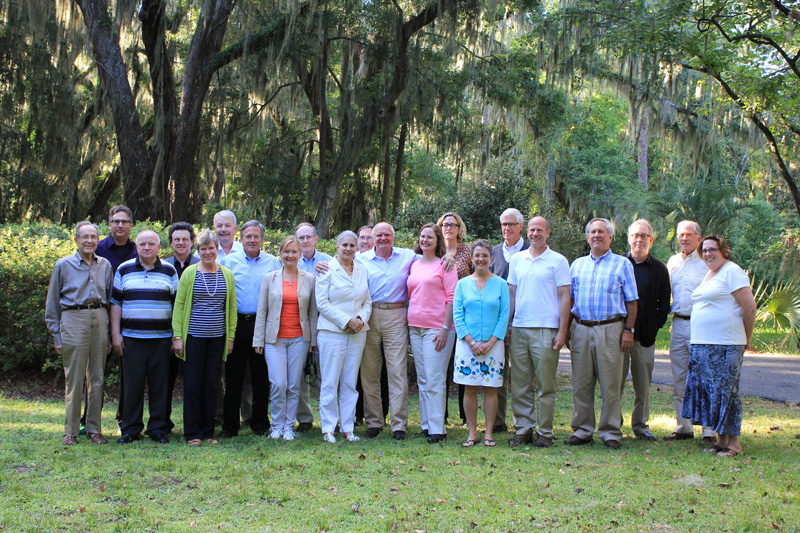 The Nunn-Lugar conference participants, Musgrove, September 28, 2013: From left to right: Bill Perry, Adam Stulberg, Victor Yesin, Bill Potter, Rose Gottemoeller, Sergei Rogov, Tom Blanton, Svetlana Savranskaya, Richard Combs, Gloria Duffy, John Steinbruner, Evgeny Maslin, Laura Holgate, Sharon Weiner, Patricia Nicholas, Harold Smith, Andy Weber, David Hoffman, Bill Burr, Sam Nunn, Sue Bechtel. With the support of the Carnegie Corporation of New York, as well as the Arca and Brenn foundations, the Musgrove conference marks the beginning of a multi-year research project on the Nunn-Lugar experience, seeking to open the still-secret files in Washington, Moscow, and elsewhere, and convene eyewitnesses and experts for a systematic forward-looking review of Nunn-Lugar to draw lessons and models for U.S.-Russian cooperation and future denuclearization efforts. The Archive effort includes a series of interviews of key protagonists who could not attend the first session at Musgrove (such as Senator Lugar), and a series of follow-on gatherings of veterans in Kazakhstan, Russia, and Ukraine. The Archive's method of "critical oral history" brings together eyewitnesses, experts, scholars and documents in mutual interrogation about the recent history and the future lessons of Nunn-Lugar. This methodology, originally developed by professors James Blight and janet Lang (at Harvard, Brown, and now the Balsillie School at the University of Waterloo, Canada) with the Archive's documentary support, has produced remarkable revelations and insights (and multiple award-winning books and films) on topics ranging from the Cuban Missile Crisis to the escalation of the Vietnam War to the collapse of Communism in Eastern Europe to current US-Iran relations. To ground the Musgrove discussions in the primary sources, Archive staff prepared a 450-page conference briefing book containing 70 key documents, primarily on the early Nunn-Lugar years from 1991 through 1997, but also including the March 2013 summary of Nunn-Lugar success that is featured on The Lugar Center website. The documents range from telcons of President George H. W. Bush's conversations with then-Soviet leader Mikhail Gorbachev about safe dismantling of nuclear warheads in 1991, to the memcons of the Bush meetings with Russian President Boris Yeltsin in 1992 on nuclear weapons withdrawal from the former Soviet republics, to the State Department cables about negotiations with Ukraine over the Soviet-era nuclear weapons located there. Sources of the documents range from Freedom of Information Act requests to the Bush Presidential Library, to donations by veterans such as Ambassador James Goodby and experts such as David Hoffman, to files at the Archives of the Russian Federation in Moscow and at the Hoover Institution at Stanford. Today's posting is the first in the Nunn-Lugar series of electronic briefing books in Russian and English that will make widely available the documents from all sides. The transcripts of the "critical oral history" conferences organized by the Archive will provide the foundation for one or more books analyzing the Nunn-Lugar experience, and will guide further research both by the Archive staff and by the conference participants. Maintaining this expert dialogue about the cooperative threat reduction experience will also make a significant contribution to the ongoing challenge of U.S.-Russia engagement.
Conference AgendaParticipant BiographiesDOCUMENTS8. Letter from President Yeltsin to President Bush, November 1991 11. Draft Cable to USNATO for November 27 NAC Session on Ukrainian Independence, November 1991 17. Memorandum of Conversation between President Bush and President Yeltsin, February 1, 1992 18. Cable, American Embassy Alma Ata, "Defining American Interests in Kazakhstan," February 18, 1992 23. Letter from President Nazarbayev to President Bush, May 19, 1992 24. Letter from James Baker to President Nazarbayev, May 19, 1992 27. Memorandum from James Baker to President Bush, "Your Meetings with Boris Yeltsin," June 11, 1992 30. Memorandum of Conversation between President Bush and President Kravchuk, July 9, 1992 35. Privacy Channel Message from President George Bush to President Yeltsin, November-December 1992 40. Department of State, Talking Points for Ambassador Goodby on SNDV Dismantlement, April 19, 1993 42. "Draft Security Assurance," circa July 1993 46. Under Secretary of Defense Frank Wisner Letter to Senator Sam Nunn, November 17, 1993 48. "Ukraine Chronology," prepared by Ambassador James Goodby, circa January 1994 55. Report by Vitaly Kataev on the State of Nuclear Weapons in Ukraine, September 16, 1994 59. Information Note to I.P. Rybkin on the State of U.S.-Russian Relations, April 25, 1995 60. Letter to the Prime Minister of the Russian Federation V.S. Chernomyrdin, May 1995 67. Cable, Secretary of State, "INR Viewpoint: Eurasian Foreign Policy Update," May 23, 1997 68. Cable, Secretary of State, "Syria: Chemical Weapons" [Excerpt], July 7, 1998 70. Chart, "The Nunn-Lugar CTR Scorecard," as of March 31, 2013
|
Nunn-Lugar RevisitedDocuments detail "proliferation in reverse" success storyU.S.-Russian cooperation on threat reduction from the Soviet Union in 1991 to Syria in 2013National Security Archive Electronic Briefing Book No. 447Edited By Tom Blanton and Svetlana Savranskaya with Anna Melyakova For more information contact: |

